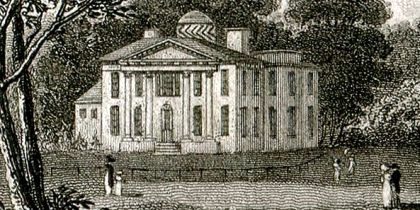SANDYS, Francis
Francis Sandys, son of Dublin architect Francis Sandys (died 1795) and his wife Elizabeth née Sheilds who married in Wicklow on 23 October 1752. Young Francis was an Irish-born architect and in March 1789 Faulkner's 'Dublin Journal' drew the attention of the public to 'An elegant fountain…now constructing in Smithfield' to the design of 'that ingenious young Architect Mr Francis Sandy, jun.' and at Easter 1790 young Francis was admitted a freeman of the city of Dublin as a member of the Merchants' Guild by virtue of birth. Around 1790, his brother Joseph Sands (1758-1822) was living in Co. Derry as domestic chaplain to Frederick Augustus Hervey (1730–1803), 4th Earl of Bristol and Bishop of Derry, whilst also acting as clerk of works for the construction of Hervey's new house at Ballyscullion, Co. Londonderry begun in 1787 and in 1791 Francis moved from Dublin to join his brother in Co. Derry in the hope of Hervey's patronage. Hervey encouraged Francis to visit Rome 1791–1796 and supported his travels financially. Sandys set out for Rome in July 1791, when Hervey wrote a letter of introduction to sculptor Antonio Canova (1757–1822) on his behalf and had arrived in Rome by the beginning of September and remained there for four and a half years. In November 1794 Hervey appeared in Rome on his final visit to the city and he commissioned Charles Heathcote Tatham (1772-1842), a young English architect, to design his new villa at Ickworth and arranged a meeting between Tatham and Sandys. The Tatham commission came to nothing; instead, Hervey settled on designs by Tatham's friend Mario Asprucci (1764–1804). When Sandys left Italy in April 1796, he went directly to Ickworth to superintend construction of the house to Asprucci's plans with modifications by himself. His brother Joseph made a striking wood and papier maché model of the house. Ickworth House at Horringer, Bury St Edmund's, Suffolk consisted of a Pantheon-domed elliptical rotunda connected to wings by quadrants similar to the Earl-Bishop's great house at Ballyscullion. Sandys married at St Mary's Church, Bury St Edmund's on 10 April 1798 Catherine Molineux, daughter of the late Crisp Molineux (1730-1792), formerly Member in Parliament for King's Lynn, Norfolk and his wife Catherine, daughter and heiress of George Montgomerie of Thundersley, Essex. Francis remained in Bury St Edmunds, Suffolk, where he built up his practice, designing Finborough Hall, Suffolk (1795), the entrance-lodges at Chippenham Park, Cambridgeshire, the Assembly Rooms, now Athenaeum, in Bury St Edmunds in 1804 designs for which he exhibited at the Royal Academy. In 1807 when living at Manchester Street, London he took as an indentured apprentice a Henry Austin. In 1809 he contracted to design and build a courthouse at Durham, but with disastrous consequences, when the building was badly carried out by dishonest workmen and had to be rebuilt. The Durham magistrates sued Sandys and were awarded £20,000 damages against him. Sandys was ruined, and left the country and is probably the Francis Sandys, whose death was reported at 247 Rue Saint-Honoré, Paris in May 1822 by a Mrs Catherine Sandys, his age being given as 53.
Royal Academy Exhibits
1797 1066 Ickworth House, Suffolk, now building
1116 A Triumphal Bridge
from Bury St Edmund's
1800 939 Great Finborough Hall, Suffolk
952 Worlingham Hall
1802 977 Entrance to Chippenham, Cambridgeshire, the seat of J. Tharp, Esq.
990 Design of London Bridge and entrance for shipping between London and Blackfriars Bridges
1806 841 Downing College
924 The New Assembly Rooms at Bury St Edmunds
from 23 Manchester Street, Manchester Square, London
1807 1005 Entrance to a Park
1106 Design for a Bridge at Staines
1808 839 Buildings intended for the West of England
1809 799 Design for West Dean House, county of Sussex, the seat of Lord Selbey
800 Design made for a front of the Royal Palace at Casetta in the Kingdom of Naples
839 Design for the entrance into a family burial place in the North of England
851 Design for the Courts of Justice in the County Palatine of Durham
Works by This Artist

|
Finborough Hall |